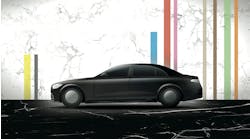Oklahoma City, April 25, 2012—New corporate average fuel economy (CAFE) standards passed by the Obama administration in 2011 are causing auto manufacturers to use a higher amount of aluminum material in vehicle designs, said Greg Horn, vice president of industry relations for Mitchell International, during the Collision Industry Conference (CIC) meeting Wednesday in Oklahoma City.
Horn said auto manufacturers are required to meet CAFE standards of 35.5 mpg for all cars and trucks sold in the U.S. by 2016, and 54.5 mpg by 2025. Horn said use of electric vehicles and hybrid electric vehicles will help manufacturers achieve greater fuel economy averages, but widespread use of those vehicles is not expected for several years.
As a result, auto manufacturers are turning to higher-strength, lighter-weight materials within vehicle construction to meet the new CAFE standards. According to Mitchell’s first quarter 2012 Industry Trends Report, vehicles experience a 2 to 3 percent fuel economy improvement for every 220 pounds in weight reduction.
Manufacturers are turning their focus to the use of aluminum components, and decreasing use of traditional high-strength steel as an overall percentage of vehicle material mix, said Rick Tuuri, vice president of industry relations for Audatex, a Solera Company. There is an average of 343 pounds of finished aluminum per vehicle within 2012 models, up from 327 pounds per vehicle in 2009.
Tuuri said aluminum is currently the dominant material for powertrain, heat exchangers and road wheels, but the material is rapidly gaining popularity for use on hoods, trunk lids, bumpers, steering knuckles and suspension arms.
Horn added that 30.5 percent of vehicle hoods on 2012 models are made of aluminum, up from 23.3 percent in 2009. It’s predicted that 41 percent of hoods will be made of aluminum by 2017, and 53 percent by 2025, he said.
Tuuri said the need for high-strength, lightweight vehicles could also cause auto manufacturers to use an increased amount of carbon fiber composites. Carbon fiber composites are 30 percent lighter than aluminum, and 50 percent lighter than steel. He said that BMW plans to roll out electric cars with entire passenger cabins made from a carbon fiber reinforced plastic by the end of 2013. The body of BMW’s i3 model is expected to be 550 to 770 pounds lighter than other vehicles of comparable size.
But mass production of carbon fiber composites remains a challenge for manufacturers, Tuuri said. The material typically costs 10 times more than aluminum, and 30 times more than steel. For example, Tuuri said the hood of a 2010 Corvette ZR01 made of carbon fiber costs $5,897, compared to $1,023 for one made of traditional metal.
Tuuri said the trend of high-strength, lightweight vehicle materials will likely cause the collision repair industry to experience an increased amount of parts replacement rather than repair, along with increased overall repair costs in the future.



